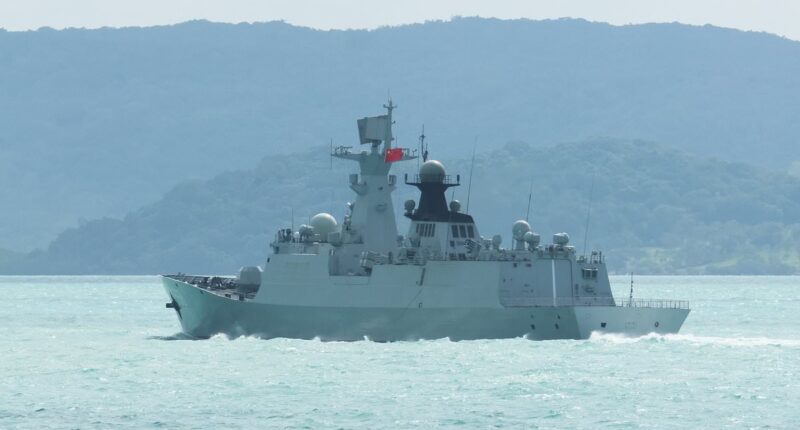China’s military presence near Australia recently increased as a fleet of warships was located close to the country, alongside a startling incident where a Chinese navy helicopter flew within 10 feet of a Philippines coastguard plane. These actions marked a significant display of China’s military strength.
The Chinese warships were identified just 150 nautical miles east of Sydney, representing the farthest south the Beijing navy has ventured along Australia’s eastern coastline. This maneuver has caught the attention of regional naval forces and raised concerns about China’s naval activities in this particular area.
Responding to the situation, the Australian Navy promptly dispatched two vessels to monitor and track the movements of the Chinese naval task group. This task group includes a frigate, a cruiser, and a supply ship, signifying a notable presence and capability within the region. The deployment of Australian vessels aims to ensure maritime security and uphold surveillance in the face of this unexpected military proximity.
The fleet was first detected off Australia’s north-east coast a week ago, raising concerns over China’s expanding military presence in the Pacific.
A defence expert described the situation as ‘unprecedented,’ warning that Beijing is increasingly normalising its military reach beyond the first and second Pacific island chains, which stretch from Japan through Indonesia, Guam, and Micronesia.
It comes after China was slammed for its ‘dangerous, unprofessional, and reckless’ actions after a Chinese navy helicopter flew just 10ft from a Philippine coastguard plane on Tuesday.
‘As the Chinese test their ability to project power further south, in addition to east and west, the question becomes how much they can hold at risk – how much they can signal to the Australians that they can threaten them,’ Charles Edel, a specialist in Australian security at Washington-based think-tank CSIS, told the FT.
The Australian Defence Ministry confirmed the Chinese ships were operating in international waters, but their presence has been met with suspicion.

China’s People’s Liberation Army-Navy Jiangkai-class frigate Hengyang, part of a task group operating to the north east of Australia

An aircraft identified by the Philippine Coast Guard as Chinese Navy helicopter (L) flies near the Bureau of Fisheries and Aquatic Resources (BFAR) plane during an aerial reconnaissance flight at Scarborough Shoal in the South China Sea on February 18, 2025
The fleet includes the frigate Hengyang and cruiser Zunyi, both of which belong to the People’s Liberation Army Navy (PLAN).
Defence expert Euan Graham from the Australian Strategic Policy Institute (ASPI) in Canberra warned that China’s military actions in the region are becoming increasingly aggressive.
He noted that Beijing has a history of ‘unsafe responses’ to Australian maritime activity, particularly in contested waters.
The Pentagon has previously warned that China is expanding its naval capabilities far beyond East Asia.
While Beijing insists it has the right to develop its military, regional analysts say the latest deployment is part of a wider effort to challenge Australian and US influence in the Pacific.
Richard McGregor of the Lowy Institute warned the newspaper that the presence of Chinese warships off Australia ‘demonstrates consistency’ and that the country is continuing to increase its naval patrols in the region.
Chinese naval vessels last visited Sydney in 2019, but that visit was pre-arranged with the Australian government.
In contrast, this latest operation appears to be an independent show of strength from Beijing.
The deployment coincides with a visit from Admiral Samuel Paparo, the head of US Indo-Pacific Command, who recently met with Australian Defence Minister Richard Marles and Foreign Minister Penny Wong.
With tensions rising, Australia and its allies are watching closely as China continues to assert its growing military influence in the Pacific.

Chinese warships were discovered just 150 nautical miles east of Sydney, marking the furthest south Beijing’s navy has ever ventured along Australia’s eastern coastline

The fleet includes the frigate Hengyang and cruiser Zunyi (pictured), both of which belong to the People’s Liberation Army Navy (PLAN)

The Philippines has vowed to file a formal diplomatic protest following the incident
On Tuesday China was blasted after one of its navy choppers was seen flying within 10ft of a Philippine coastguard plane, putting the lives of both the crew and passengers at serious risk.
The encounter occurred over the contested Scarborough Shoal, located in the South China Sea, an area claimed by China but also heavily disputed by the Philippines.
The Philippine coastguard plane, a Cessna, had been flying around 700ft above the water to monitor Chinese vessels in the region when the helicopter swooped in dangerously close to the plane’s left wing.
Commodore Jay Tarriela, a spokesman for the Philippine coastguard, called the incident ‘extremely dangerous,’ noting that the Chinese helicopter came within a mere 10ft of the aircraft, putting its stability at risk.
Tarriela emphasised that this was the first known instance of such a close encounter between a Chinese navy helicopter and a Philippine patrol plane.
The Scarborough Shoal, a chain of reefs and rocks seized by China from the Philippines in 2012, remains a flashpoint in the ongoing territorial dispute.
China claims almost all of the South China Sea, including the Shoal, despite an international court ruling in 2016 declaring its claims to be without legal merit.
In response, Tian Junli, spokesman for China’s Southern Theatre Command, accused the Philippine aircraft of ‘illegally intruding’ into Chinese airspace over Huangyan Island, the Chinese name for Scarborough Shoal.
He insisted that Chinese naval and air units had been dispatched to ‘track, monitor, warn, and expel the aircraft’ in accordance with Chinese law, claiming that the Philippine actions violated China’s sovereignty.
The Philippines has vowed to file a formal diplomatic protest following the incident.
The United States quickly condemned China’s actions.

An airman aboard a Philippine Bureau of Fisheries and Aquatic Resources plane looks on as a Chinese Navy helicopter flies close by above Scarborough Shoal on February 18, 2025 in the South China Sea

The incident occurred when the Chinese Navy deployed a helicopter to tail the Philippine civilian plane, which was conducting a routine maritime domain awareness flight over Scarborough Shoal, located within the Philippines’ exclusive economic zone

The Philippines has been vocal in its opposition to China’s increasing assertiveness in the region
MaryKay Carlson, the U.S. Ambassador to Manila, expressed deep concern over the dangerous maneuvers and called on China to cease its ‘coercive actions.’
She urged Beijing to resolve its territorial disputes through peaceful means and in line with international law.
This latest incident comes just days after Australia rebuked China for similar ‘unsafe’ conduct.
In that case, a Chinese fighter jet had reportedly released flares within 30 metres of an Australian surveillance plane over the South China Sea.
The Chinese government responded by accusing the Australian aircraft of ‘deliberately intruding’ into China’s claimed airspace near the Paracel Islands, also contested by Vietnam and Taiwan.
The Philippines has been vocal in its opposition to China’s increasing assertiveness in the region.
In December, Manila accused China’s coastguard of using water cannons and even sideswiping a Philippine fisheries vessel.
A video released by the Philippine government showed a Chinese coastguard ship directing a powerful jet of water at the BRP Datu Pagbuaya.
Philippine officials, who have strengthened their defense cooperation with the US under President Ferdinand Marcos, have been seeking to secure their maritime interests, including acquiring the US Typhon missile system, which has a range of up to 300 miles.
China has warned that the acquisition of such a system would escalate tensions in the region and risk sparking an ‘arms race.’
The tensions in the South China Sea show no signs of abating, as both China and the Philippines, along with their respective allies, continue to challenge each other’s influence in the region.

















